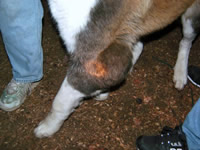Ever notice a lump forming on your dog's elbows? Usually, it's on one of the front legs. But, more than likely, it is a hygroma growth. A hygroma growth is a fluid-filled sac that is formed on the elbow. Vets believe it's caused by the dog irritating the elbow by lying on hard surfaces or favoring one elbow over the other when lying down. The sac forms below the skin and feels firm but is yielding and somewhat mobile within the loose skin.
At first, the bursa may not be painful, but it can become very sore and swollen as the dog ages. Eventually, the growth can become ulcerated and harm the joint and bone.
What causes a hygroma?
A hygroma is caused by repeated trauma to an area over a bony prominence, like an elbow or hip bone. The trauma most often occurs due to lying on hard surfaces, such as cement or hardwood/tile floors. It is more common in larger breed dogs in which more weight is placed on the bony area having contact with the hard surface. Hygromas are also more common in sedentary dogs, such as those recovering from surgery or having other medical conditions that make them less active (e.g., hip dysplasia).
How is a hygroma treated?
The first step in treatment is to prevent further trauma. Preventing further trauma can be accomplished by providing a soft padded bed or bandaging the area. The area involved can be bandaged using donut-shaped padding over the elbow, placing the donut's 'hole' over the hygroma protecting the hygroma from further contact with anything hard. Simply bandaging the area is often ineffective since there would still be pressure on the hygroma if the dog lies on that side. There are commercial products available for protecting the elbows and for dogs with hygromas.
The conventional veterinary hygroma treatment is to drain the fluid with a needle, then pressure wrapping the leg to stop the swelling in the elbow from reforming. However, periodically aspirating (removing the fluid via needle and syringe) the hygroma is usually ineffective and may introduce infection. Likewise, surgery is seldom performed unless the hygroma is infected.
Generally, the area involved is so large that skin grafting or other techniques may be needed to close the incision once the hygroma is removed. When the animal flexes and extends the leg, considerable tension is placed on the sutures, and the incision is likely to open up. Some success has been seen by surgically inserting a drain (latex tubing) into the hygroma to allow for constant drainage for a prescribed time (usually a week). Then the area is bandaged, and the dressings are changed regularly. The tube acts to grow scar tissue within the elbow and allows elbow fluid to drain for an entire week. When the tube comes out, the scar tissue remains, and the theory is the scar tissue does not allow fluid to build up again. Vets are successfully treating dogs with hygroma with the Penrose drain hygroma treatment, and to date, seeing a huge success rate.
Dog Beds can help correct this problem by giving your dog a soft place to lie down.

What can you do to help? Click for more information.

